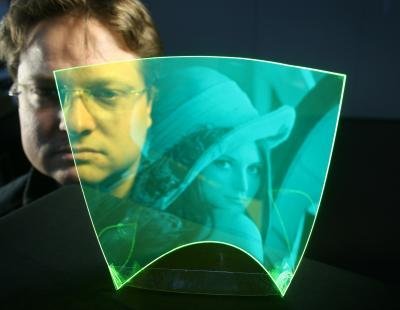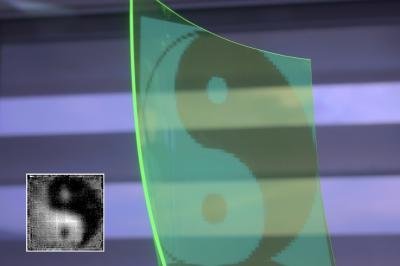New imaging device is flexible, flat and transparent
An Austrian research team has developed an entirely new way of capturing images based on a flat, flexible, transparent and potentially disposable polymer sheet. The team describes their new device and its possible applications in a paper published in The Optical Society’s (OSA) open-access journal Optics Express.
The new imager, which resembles a flexible plastic film, uses fluorescent particles to capture incoming light and channel a portion of it to an array of sensors framing the sheet. With no electronics or internal components, the imager’s elegant design makes it ideal for a new breed of imaging technologies, including user interface devices that can respond not to a touch but merely to a simple gesture.

“To our knowledge, we are the first to present an image sensor that is fully transparent - no integrated microstructures, such as circuits - and is flexible and scalable at the same time,” said Oliver Bimber of the Johannes Kepler University Linz in Austria, co-author of the paper.
The sensor is based on a polymer film known as a luminescent concentrator (LC), which is suffused with tiny fluorescent particles that absorb a very specific wavelength (eg, blue light) and then re-emit it at a longer wavelength (eg, green light). Some of the re-emitted fluorescent light is scattered out of the imager, but a portion of it travels throughout the interior of the film to the outer edges, where arrays of optical sensors (similar to 1D pinhole cameras) capture the light. A computer then combines the signals to create a grey-scale image.
“With fluorescence, a portion of the light that is re-emitted actually stays inside the film,” said Bimber. “This is the basic principle of our sensor.”
For the luminescent concentrator to work as an imager, Bimber and his colleagues had to determine precisely where light was falling across the entire surface of the film. This was the major technical challenge because the polymer sheet cannot be divided into individual pixels like the CCD camera inside a smartphone. Instead, fluorescent light from all points across its surface travels to all the edge sensors. Calculating where each bit of light entered the imager would be like determining where along a train line a passenger got on after the train reached its final destination and all the passengers exited at once.
The solution came from the phenomenon of light attenuation, or dimming, as it travels through the polymer. The longer it travels, the dimmer it becomes. So by measuring the relative brightness of light reaching the sensor array, it was possible to calculate where the light entered the film. This same principle has already been employed in an input device that tracks the location of a single laser point on a screen.
The researchers were able to scale up this basic principle by measuring how much light arrives from every direction at each position on the image sensor at the film’s edge. They could then reconstruct the image by using a technique similar to X-ray computed tomography, more commonly known as a CT scan.
“In CT technology, it’s impossible to reconstruct an image from a single measurement of X-ray attenuation along one scanning direction alone,” said Bimber. “With a multiple of these measurements taken at different positions and directions, however, this becomes possible. Our system works in the same way, but where CT uses X-rays, our technique uses visible light.”
Currently, the resolution from this image sensor is low (32 x 32 pixels with the first prototypes). The main reason for this is the limited signal-to-noise ratio of the low-cost photodiodes being used. The researchers are planning better prototypes that cool the photodiodes to achieve a higher signal-to-noise ratio.

By applying advanced sampling techniques, the researchers can already enhance the resolution by reconstructing multiple images at different positions on the film. These positions differ by less than a single pixel (as determined by the final image, not the polymer itself). By having multiple of these slightly different images reconstructed, it’s possible to create a higher resolution image.
“This does not require better photodiodes,” noted Bimber, “and does not make the sensor significantly slower. The more images we combine, the higher the final resolution is, up to a certain limit.”
The main application the researchers envision for this new technology is in touch-free, transparent user interfaces that could seamlessly overlay a television or other display technology. This would give computer operators or video-game players full gesture control without the need for cameras or other external motion-tracking devices. The polymer sheet could also be wrapped around objects to provide them with sensor capabilities. Since the material is transparent, it’s also possible to use multiple layers that each fluoresce at different wavelengths to capture colour images.
The researchers also are considering attaching their new sensor in front of a regular, high-resolution CCD sensor. This would allow recording of two images at the same time at two different exposures.
“Combining both would give us a high-resolution image with less overexposed or underexposed regions if scenes with a high dynamic range or contrast are captured,” Bimber said. He also noted that the polymer sheet portion of the device is relatively inexpensive and therefore disposable.
“I think there are many applications for this sensor that we are not yet aware of,” he concluded.
Mid-infrared microscope used to look inside bacteria
Researchers have constructed an improved mid-infrared microscope, enabling them to see the...
Water-based paints contain potentially hazardous chemicals
Some water-based paints contain compounds that are considered volatile organic compounds, along...
Portable device enables regular testing for kidney disease
Accessible, affordable urinalysis to assess kidney function could be a boon in remote areas as...







